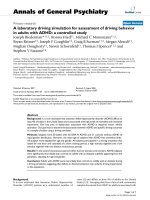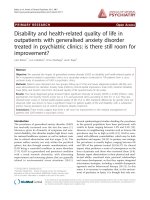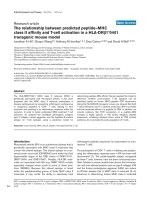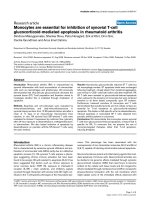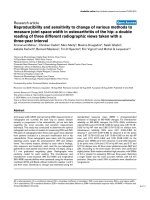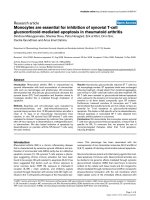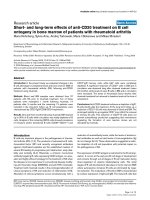Báo cáo y học: "Extracorporeal life support for management of refractory cardiac or respiratory failure: initial experience in a tertiary centre" docx
Bạn đang xem bản rút gọn của tài liệu. Xem và tải ngay bản đầy đủ của tài liệu tại đây (543.42 KB, 8 trang )
Peris et al. Scandinavian Journal of Trauma, Resuscitation and Emergency Medicine 2010,
18:28
Open Access
ORIGINAL RESEARCH
© 2010 Peris et al; licensee BioMed Central Ltd. This is an Open Access article distributed under the terms of the Creative Commons
Attribution License ( which permits unrestricted use, distribution, and reproduction in
any medium, provided the original work is properly cited.
Original research
Extracorporeal life support for management of
refractory cardiac or respiratory failure: initial
experience in a tertiary centre
Adriano Peris
1
, Giovanni Cianchi
1
, Simona Biondi
2
, Manuela Bonizzoli
1
, Andrea Pasquini
1
, Massimo Bonacchi
3
,
Marco Ciapetti
1
, Giovanni Zagli*
1
, Simona Bacci
1
, Chiara Lazzeri
4
, Pasquale Bernardo
4
, Erminia Mascitelli
3
, Guido Sani
3
and Gian Franco Gensini
4
Abstract
Introduction: Extracorporeal Life Support (ECLS) and extracorporeal membrane oxygenation (ECMO) have been
indicated as treatment for acute respiratory and/or cardiac failure. Here we describe our first year experience of in-
hospital ECLS activity, the operative algorithm and the protocol for centralization of adult patients from district
hospitals.
Methods: At a tertiary referral trauma center (Careggi Teaching Hospital, Florence, Italy), an ECLS program was
developed from 2008 by the Emergency Department and Heart and Vessel Department ICUs. The ECLS team consists
of an intensivist, a cardiac surgeon, a cardiologist and a perfusionist, all trained in ECLS technique. ECMO support was
applied in case of severe acute respiratory distress syndrome (ARDS) not responsive to conventional treatments. The
use of veno-arterial (V-A) ECLS for cardiac support was reserved for cases of cardiac shock refractory to standard
treatment and cardiac arrests not responding to conventional resuscitation.
Results: A total of 21 patients were treated with ECLS during the first year of activity. Among them, 13 received ECMO
for ARDS (5 H1N1-virus related), with a 62% survival. In one case of post-traumatic ARDS, V-A ECLS support permitted
multiple organ donation after cerebral death was confirmed. Patients treated with V-A ECLS due to cardiogenic shock
(N = 4) had a survival rate of 50%. No patients on V-A ECLS support after cardiac arrest survived (N = 4).
Conclusions: In our centre, an ECLS Service was instituted over a relatively limited period of time. A strict collaboration
between different specialists can be regarded as a key feature to efficiently implement the process.
Introduction
Extracorporeal circulation support techniques have been
proposed either for treatment of cardiac and/or pulmo-
nary failure refractory to conventional treatments in
adult patients. The first device, which assured blood
extracorporeal oxygenation and perfusion of isolated
organs, was developed by von Frey and Gruber in 1885
[1]. The first heart-lung machine was projected by Gib-
bon in 1937 in order to allow open-heart surgical opera-
tions [2]. Over the years, extracorporeal circulation
circuit has been improved and the technique optimized,
and it is now available for clinical practice. From a general
point of view, two methods of support are outlined: veno-
venous extracorporeal oxygenation, commonly known as
ECMO, Extracorporeal Membrane Oxygenation, for
respiratory function substitution and extracorporeal life
support technique (ECLS) with a veno-arterial circula-
tion for both oxygenation and hemodynamic assistance.
The major indications for ECMO, in adult patients, are
severe acute respiratory distress syndrome (ARDS)
refractory to conventional treatments [3,4], and, in
selected cases, post-traumatic respiratory failure, severe
asthma [5,6], and chronic lung disease waiting for lung
transplantation [7,8].
The indications for ECLS and cardiac support are cardiac
failure due to any cause, and cardiac arrest not responsive
* Correspondence:
1
Anaesthesia and Intensive Care Unit of Emergency Department, Careggi
Teaching Hospital, Florence, Italy
Full list of author information is available at the end of the article
Peris et al. Scandinavian Journal of Trauma, Resuscitation and Emergency
Medicine 2010, 18:28
Page 2 of 8
to Advanced Life Support manoeuvres. In the first case,
the in-hospital mortality rate is still high (between 33%
and 38%) and ECLS represents a rescue-therapy useful
for refractory patients [9]. In case of in-hospital cardiac
arrest, when ECLS was used after ten minutes of unsuc-
cessful cardiopulmonary resuscitation, an increase in sur-
vival rate at ICU discharge, at 30-day and at 1-year
survival was reported [10].
At a tertiary referral trauma center (Careggi Teaching
Hospital, Florence, Italy) an ECLS program was devel-
oped beginning April 2008 by the Intensive Care Unit of
Emergency Department in association with the Intensive
Cardiac Coronary Unit of Heart and Vessel Department.
Here we describe our experience in implementing a mul-
tidisciplinary ECLS team for cardiac and respiratory fail-
ure. In addition to reporting our clinical experience, we
present the algorithm for ECLS activation for in-hospital
cardiac arrest and the experience of a national referral
center for treatment of H1N1 influenza related respira-
tory failure.
Methods
ECLS Team
The ECLS team consists of an intensivist, a cardiac sur-
geon, a cardiologist and a perfusionist, all trained on
ECLS technique and management. According to our acti-
vation protocol, ECLS team can be summoned within
one hour, with 24 hour coverage.
In most cases, the intensivist primes the process on the
basis of clinical and radiological findings and activates the
full ECLS team. The cardiologist's main task is to evaluate
cardiac function in the pre-ECLS phase and guides the
correct positioning of ECLS cannulas by transesophageal
ultrasonography. Furthermore, the cardiologist is directly
involved in selecting patients with cardiac failure suitable
for ECLS treatment. The cardiac surgeon, in addition to
actively participating to the clinical decision making pro-
cess, is responsible for selecting and inserting the cannu-
las and starting the extracorporeal circulation, with the
assistance of the perfusionist.
In case of an ECLS run, irrespectively of the unit where
the patient was admitted (General or Cardiac ICU), all
the professionals of the team were available for consulta-
tion and performed at least one daily evaluation.
This study, supported by institutional funds only, fol-
lowed the principles of the Helsinki declaration and was
approved by the Internal Review Board. Informed con-
sent for data publication was obtained.
ECLS for respiratory failure
Veno-venous ECLS treatment (ECMO) was applied in
case of severe ARDS not responsive to conventional
treatments, but potentially reversible. Conditions of
severe hypoxia or hypercapnia, where the limits of a pro-
tective ventilation strategy could not be maintained (tidal
volume less than 6 mL/Kg of predicted body weight and
plateau pressure less than 30 cmH
2
O), were the indica-
tions for starting extracorporeal circulation [11].
The Careggi Teaching Hospital had started a collabora-
tion with the ICUs of 12 district hospitals in Tuscany in a
pilot project for centralization of acute lung injury/ARDS
patients who require (or may require) ECLS treatment. In
2008 and spring 2009, preliminary meetings were orga-
nized to inform the peripheral hospitals' ICU staff and
Administrations about the availability of the new ECLS
program. During the H1N1 influenza A pandemic, the
knowledge of ECMO treatment rapidly spread among the
medical community and the Regional Ministry of Health
issued indications to transfer all patients affected by
severe respiratory failure related to influenza to Careggi
Hospital. In Appendix 1 is reported the set of parameters
that were adopted to quickly detect patients suitable for
extracorporeal treatment in the peripheral hospitals.
Patients deemed suitable for ECMO treatment were eval-
uated on site by the ECMO team. Depending on clinical
condition, the transfer was performed on conventional
ventilation or, alternatively, ECLS treatment was initiated
in the peripheral hospital and maintained during trans-
portation [12].
We preferentially adopted a high flow technique (5-6
litres per minute of blood flow), to maximize the oppor-
tunity of providing protective ventilation, aiming to
achieve a plateau pressure below 28 cm H
2
O and PEEP 2
cmH
2
O above the lower inflection point of the quasi-
static pressure volume curve, regardless the delivered
tidal volume (in any case less than 6 ml/kg). Controlled
respiratory frequency was reduced to 4-10/min to main-
tain normocapnia. Inspired oxygen fraction was reduced
to 0.5 or lower, whenever possible. A recruitment
manoeuvre was performed at least once a day, and venti-
lation with an intermittent high pressure breath ("sigh")
was adopted to improve lung aeration [13]. During
ECMO, nitric oxide administration [14], vasoactive sup-
port, and prone positioning were maintained or initiated
according to clinical conditions.
ECLS for hemodynamic support
The use of ECLS for cardiac support was reserved for
cases of cardiac shock refractory to standard treatments
and cardiac arrests not responding to conventional resus-
citation. According to our internal protocol, ECLS was
adopted also as a bridge to implantation of Left Ventricu-
lar Assist Device or to heart transplantation [15].
ECLS was employed in cases of in-hospital cardiac arrest
when the patient was considered to have a good chance of
recovery both for clinical conditions and for the timing of
resuscitation. An age limit of seventy years, severe irre-
versible brain damage, terminal malignancy, pre-signed
Peris et al. Scandinavian Journal of Trauma, Resuscitation and Emergency
Medicine 2010, 18:28
Page 3 of 8
"do not attempt resuscitation" orders and contraindica-
tions to prolonged systemic heparin infusion were the
only strict exclusion criteria taken into account. In case of
cardiac arrest, hypothermia was rapidly initiated and was
maintained for 24 hours at a temperature between 32-
34°C [16].
Veno-arterial (V-A) ECLS treatment was considered con-
traindicated, when a severe aortic incompetence, aortic
dissection or ventricular thrombosis was detected by
echocardiography.
Equipment
The ECLS circuit consisted of a Rotaflow Maquet Cen-
trifugal Pump (Maquet, Rastatt, Germany) and a hollow
fiber membrane oxygenator (Quadrox-D Oxygenator,
Maquet, Rastatt, Germany), connected with biocoated
tubes. In the V-A circuit, blood was drained through fem-
oral vein and reinfused into aorta through femoral artery.
For V-V ECLS two types of cannulas were used. At the
beginning, Raumedic cannulas ranging from 21 to 28
french (Raumedic AG, Germany) were employed with
femoral and jugular vein cannulation. Since July 2009,
Avalon Elite™ Bi-Caval Dual Lumen Catheters have
become available. These specially designed dual lumen
cannulas, inserted in the right internal jugular vein, per-
mit both drainage and reinfusion of blood. In V-A ECLS,
the distal perfusion of the limb could be jeopardized by
the relatively large bore inflow cannula, inserted in the
femoral artery at the groin: to prevent leg ischemia, we
usually inserted a small shunt cannula (14 french) in the
femoral artery, distally to the ECLS cannula. Heparin
therapy was titrated by bedside measurement of activated
partial thromboplastin time (aPTT) with Hemochron
(Hemochron Jr. Sign. plus, ITC Europe, Milan, IT) every
two hours.
Numerical data were summarised as median and inter-
quartile range.
Results
A total of 21 patients were treated with ECLS during the
first one year of activity (April 2008 - December 2009).
Among them, 13 were treated with ECMO for respiratory
failure (Table 1), and 8 were treated with V-A ECLS due
to cardiac arrest (Table 2) and cardiogenic shock (Table
3). The most frequent complication observed was local
bleeding from the insertion points of the cannulae, cen-
tral line access site and tracheostomy (36%). In one case,
oxygenator failure occurred due to clots formation; in this
occasion a rapid increase of D-Dimers was observed, fol-
lowed by a worsening of oxygenation and decarboxyla-
tion performance of the artificial lung. Circuit change
was promptly carried out with no further complications.
In one case of V-A ECLS, major bleeding occurred at site
of cannulae insertion several days after successful wean-
ing, requiring multiple transfusions. At surgical inspec-
tion a femoral artery wall lesion was found and required
prosthetic repair.
Five patients received renal replacement therapy (contin-
uous veno-venous hemofiltration, CVVH). The CVVH
was connected in-line to the extracorporeal circuit with
the withdrawal line before oxygenator and return line
after the oxygenator. Renal function recovered in all
cases, and both ECLS and CVVH run was uneventful on
this configuration.
During extracorporeal support, invasive procedures were
carried out without any immediate complications.
Among these, four bedside percutaneous tracheotomies
(Ciaglia technique) were performed, and two narrow bore
pleural catheters were inserted under ultrasound guid-
ance for massive pleural effusions. Autopsy was per-
formed in all non surviving patients and no lesion of
vessels due to the presence of cannulae was observed.
ECMO for respiratory failure
A total of 13 patients were treated with ECMO for ARDS:
six patients were affected by bacterial pneumonia, five
patients had H1N1-related ARDS (two with Legionella
Pneumophila superinfection), and 2 patients presented
trauma-related respiratory failure. Data of each patient
are represented in Table 1. Median age was 59 years (IQR
44-65), with a prevalence of male sex (85%). Median ICU
length of stay was 17 days (IQR 13-20). Eight out of 13
patients were successfully weaned from ECMO and dis-
charged from ICU (overall survival rate of 62%). All
H1N1 patients were discharged from ICU and from hos-
pital.
The median duration of ECMO was 235 hours (IQR 151-
269), with a difference between survivors (221 hours) and
non survivors (257 hours). We considered time from veri-
fication of ECMO criteria to extracorporeal support start
as an efficiency parameter ("time to ECMO"), and it was 6
hours (IQR 4-9).
From October 2009, when our ECMO Service became
the referral centre of Central Italy for H1N1-induced
ARDS, extracorporeal support was initiated in the
peripheral hospital in 3 cases. Inter-hospital transport
was safely performed on extracorporeal support and all
patients were discharged alive from ICU.
One young patient (19 years) died due to severe traumatic
brain injury. In this patient, ECMO was maintained in the
first 12 hours without systemic heparin infusion and no
complications occurred during extracorporeal treatment.
After cerebral death confirmation, multiple organ dona-
tion was accomplished. One patient (a 64 year-old
woman) died due to subarachnoidal hemorrhage,
although coagulation parameters were normal.
Peris et al. Scandinavian Journal of Trauma, Resuscitation and Emergency
Medicine 2010, 18:28
Page 4 of 8
Table 1: Patients treated with ECMO for respiratory failure.
Patients Age/Gender SAPS II at
admission
Indication Time to ECMO
from ARDS
diagnosis (days)
Hours of critical hypoxia
(PaO2/FiO2 < 60) and/or
critical acidosis
(pH < 7.20)
ECMO duration
(hours)
ECMO-related
complications
ICU LOS
(days)
ICU
outcome
Pt 1 70/M 27 ARDS
(infective)
12 4 269 Local bleeding 33 Survived
Pt 2 19/M 47 ARDS
(post-traumatic)
1433None3Non survived
Pt 3 64/F 62 ARDS
(infective)
1 2 44 Intracranial
bleeding
3Non survived
Pt 4 65/M 58 ARDS
(post-traumatic)
1 1 231 Local bleeding 65 Survived
Pt 5 69/M 29 ARDS
(infective)
1 5 264 Local bleeding 20 Survived
Pt 6 67/M 82 ARDS
(infective)
10 8 253 Local bleeding 12 Non survived
Pt 7 59/M 50 ARDS
(infective)
48626Oxygenator
failure
27 Non
survived
Pt 8 61/M 62 ARDS
(infective)
5 5 330 None 15 Non
survived
Pt 9 15/M 66 ARDS
(H1N1)
05137None17Survived
Pt 10 58/M 24 ARDS
(H1N1)
24154None13Survived
Pt 11 44/F 46 Viral acute
lung failure
(H1N1)
2 5 374 Local bleeding 20 Survived
Peris et al. Scandinavian Journal of Trauma, Resuscitation and Emergency
Medicine 2010, 18:28
Page 5 of 8
Pt 12 48/M 40 ARDS
(H1N1)
1 6 184 Local bleeding 17 Survived
Pt 13 30/M 44 Viral acute
lung failure
(H1N1)
16151None18Survived
Table 1: Patients treated with ECMO for respiratory failure. (Continued)
Table 2: Patients treated with V-A ECLS for in-hospital cardiac arrest.
Patients Age/Gender SAPS II at
admission
Diagnosis at
hospital
admission
Cardiac arrest
etiology
Initial rhythm
of cardiac
arrest
ACLS
duration to
ECLS
(minutes)
Return of
Spontaneous
Circulation
(ROSC)
ECLS duration
(hours)
ECLS-related
complications
ICU LOS
(days)
ICU outcome
Pt 1 66/F 60 Septic shock Multi Organ
Dysfunction
Syndrome
Asystole 60 No 6 None 2 Non survived
Pt 2 59/M 69 Cardiac arrest Bridge to
diagnosis
Pulseless
electrical
activity
90 Yes 25 None 2 Non survived
Pt 3 16/M 40 Trauma with
brain injury
Trauma Pulseless
electrical
activity
45 No 46 None 9 Non survived
Pt 4 23/M 80 Trauma Hemorrhagic
shock
Pulseless
electrical
activity
55 No 3 None 1 Non survived
Peris et al. Scandinavian Journal of Trauma, Resuscitation and Emergency
Medicine 2010, 18:28
Page 6 of 8
V-A ECLS for cardiac arrest and cardiogenic shock
Four victims of intra-hospital cardiac arrest received V-A
ECLS for cardiac support (Table 2). Patients were 41
years old (median, IQR 21-61; male sex 75%). The median
duration of advanced cardiac life support manoeuvres
before ECLS start was 58 minutes (IQR 53-68), and the
median duration of ECLS was 16 hours (5-30). In two
patients, the ECLS support started in the Emergency
Room. All four patients died during their ICU stay (one
patient after ECLS withdrawal).
Data of the four patients treated for cardiogenic shock are
represented in Table 3. Median age was 49 years (IQR 38-
58, male sex 50%). Among them, 2 patients survived and
were discharged from ICU. In these patients, median
duration of ECLS was 96 hours (IQR 60-137). Intraaortic
balloon pump was necessary in all four patients. Survival
rate was 50%.
Discussion
From the experience here reported, we can state that,
with a close cooperation between different specialists
(intensivist, cardiologist, cardiac surgeon, nurse, perfu-
sionist), an ECLS Service can be started over a relatively
limited period of time, achieving a high level of efficiency.
Our model of ECLS team has allowed us to start extracor-
poreal support in different hospital scenarios, such as
ICU and Emergency Room. This feature of flexibility and
adaptability of our ECMO system has made it particularly
beneficial during the Influenza A pandemic, making this
resource available also in peripheral hospitals.
The management of a patient on ECLS is still challenging
in terms of utilization of resources and commitment of
health personnel. Beyond the insertion procedure, a mul-
tidisciplinary team can better accomplish the tasks of
daily management of the patient, as an intensivist, a car-
diac surgeon and a perfusionist should repeatedly evalu-
ate the circuit and the patient to guarantee a safe and
uneventful treatment. Furthermore, every ECLS patient
needs a dedicated nurse. With the assistance of these
dedicated professionals, also in-hospital transportation
can be safely carried out (i.e. to radiological suite). In our
population 63% of patients received a CT scan during
ECLS treatment, and no transport-related complications
occurred. The most common complication was local
bleeding, usually simple to manage. In this regard, the use
of Bioline surface-heparinized circuits allowed a limited
dose of heparin, and may have reduced the incidence of
complications such as coagulation, complement activa-
tion, thrombus formation and the need for transfusions
[17-19].
The survival rate of 62% of our patients treated with
ECMO for respiratory failure is comparable to other pub-
lished studies. In 2004, Hemmila and co-workers retro-
spectively reviewed 255 patients with ARDS treated with
ECMO between 1989 and 2004, showing a 67% of
patients successfully weaned from ECMO and a hospital
discharge of 52% [20]. More recently, the CESAR (Con-
ventional ventilation or ECMO for Severe Adult Respira-
tory Failure) trial has shown an increase of survival rate,
without severe disability, 6 months after randomization
Table 3: Patients treated with V-A ECLS in case of cardiogenic shock.
Patients Age/Gender SAPS II at
admission
Cardiogenic
shock etiology
Intra Aortic
Balloon Pump
ECLS duration
(hours)
ECLS-related
complications
ICU LOS
(days)
ICU outcome
Pt 1 43/M 61 Post cardiac
arrest heart
failure-ARDS in
near-drowning
Yes 120 None 26 Survived
Pt 2 55/F 67 Multi Organ
Dysfunction
Syndrome
No 72 None 5 Non survived
Pt 3 68/M 91 Multi Organ
Dysfunction
Syndrome
No 24 None 2 Non survived
Pt 4 24/F 47 Post cardiac
arrest heart
failure
Yes 189 Local
bleeding,
aneurysm
14 Survived
Peris et al. Scandinavian Journal of Trauma, Resuscitation and Emergency
Medicine 2010, 18:28
Page 7 of 8
in patients treated with ECMO in comparison to conven-
tional ventilation (63% vs 47%) [4].
From the first phase of implementation, our service was
conceived to provide extracorporeal support even in
peripheral institutions, therefore a dedicated ambulance
was specifically prepared and all equipment arranged for
transportation. In our opinion, this is a key feature for an
effective ECMO service as inter-hospital transportation
of patients with severe respiratory failure can be challeng-
ing due to the fact that limited possibilities of interven-
tion are available and clinical deterioration may occur
[21]. Therefore, several centres recommend the start of
extracorporeal assistance before transfer [22,12]. In our
out-of-hospital ECMO experience, one patient was safety
transferred by ambulance from a distance of 400 Km.
We report quite a short time to establish V-A ECLS in
case of in-hospital cardiac arrest (58 min). Furthermore,
there is a trend towards a progressive reduction of this
interval over time. Despite this remarkable performance
of our ECLS system in terms of speed of response, no
patient receiving extracorporeal support for cardiac
arrest survived. In a large series of patients on extracor-
poreal support for in hospital cardiac arrest, Jaski and co-
workers reported a long term survival rate of 23% in wit-
nessed events and no survival in non-witnessed arrest. At
multivariate analysis cardiac arrest in the critical care
unit was found to be the only independent variable pre-
dictive of outcome [23]. In another series of 40 in-hospi-
tal cardiac arrest victims, time before ECLS was 105
minutes, and 20% survival rate was reported [24]. In our
experience, the number of cardiac arrest patients with
ECLS is so limited that comparison to published data is
not feasible. Nevertheless, the reason for not responding
to V-A ECLS treatment in our cases might be possibly
related to the severity of previous clinical condition (2
traumas, 1 septic shock) and to the underling organ dys-
function.
Conclusions
ECMO and V-A ECLS might be considered a therapeutic
option in patients with severe ARDS and/or with cardiac
failure or cardiac arrest. In our experience, a well-timed
start of ECMO in case of ARDS, prevents the progression
of ventilator-induced lung injury and increases the
chances of lung recovery. Also in case of cardiogenic
shock, an extracorporeal technique seems a viable option
and increases the possibility of early cardiac recovery
avoiding neurological damages and multi-organ failure.
To guarantee a safe treatment, the involvement of several
properly trained physicians and nurses seems advisable.
Key messages
• An ECLS Service can be effectively organized in a Cen-
ter were the needed competencies are available (intensiv-
ist, cardiologist, cardiac surgeon).
• When physicians and nurses are skilled in the tech-
nique, the Service can provide a safe transfer of critically
ill patients from remote hospitals.
• ECMO should be considered in the initial phase of
ARDS, when failure to ventilation strategy occurs.
• The resource of ECMO has resulted to be particularly
important in the event of cases of severe respiratory fail-
ure, as in the last pandemic of Influenza A.
Appendix 1: First contact criteria to discuss the
need of ECLS
The parameter are referred to a condition of lung protec-
tive ventilation's (tidal volume:4-6 ml/Kg of predicted
body weight; plateau pressure ≤ 30 cmH
2
O; PEEP > lower
inflection point of the curve pressure-volume).
PEEP: positive end-expiratory pressure; PaO
2
: arterial
oxygen partial pressure; FiO
2
: inspired oxygen fraction;
RR: respiratory rate; SaO
2
: peripheral oxygen saturation;
SvO
2
: central venous oxygen saturation.
Acute respiratory failure with 1 of the following condi-
tion:
1. SaO
2
< 85% for at least 1 hour
2. Oxygenation Index
1
>25 for at least 6 hours after venti-
lation's optimization
3. PaO
2
/FiO
2
< 100 with PEEP ≥ 10 cmH
2
O for at least 6
hours after ventilation's optimization
4. Hypercarbia with pH < 7.25
5. SvO
2
< 65% with hematocrit >30 and under vasoactive
drugs infusion
1
Mean airway pressure (cmH
2
O) * FiO
2
* 100/PaO
2
Abbreviations
ARDS: adult respiratory distress syndrome; ECLS: extracorporeal life support;
ECMO: extracorporeal membrane oxygenation; ICU: intensive care unit; PEEP:
positive end-expiratory pressure; SAPS: simplified acute physiology score; TEE:
transesophageal echocardiography.
Competing interests
The authors declare that they have no competing interests.
Authors' contributions
AP (Adriano Peris), MB, GC, AP (Andrea Pasquini), GS, GFG organized the ECLS/
ECMO Service. MB (Manuela Bonizzoli), GC, AP, SB, PB, CL reviewed the litera-
ture. SB, GC, GZ, AP wrote the draft of article. SB collected data. MB (Massimo
Bonacchi) performed all ECLS/ECMO insertion procedures. CL and PB per-
formed TEE assistance. AP (Adriano Peris), MB, GC, AP (Andrea Pasquini), MC, SB
and EM managed cases here reported. All Authors have seen and approved
the final revised version.
Acknowledgements
This paper was supported by institutional funds.
Peris et al. Scandinavian Journal of Trauma, Resuscitation and Emergency
Medicine 2010, 18:28
Page 8 of 8
Author Details
1
Anaesthesia and Intensive Care Unit of Emergency Department, Careggi
Teaching Hospital, Florence, Italy,
2
Postgraduate School of Anesthesia and
Intensive Care, Faculty of Medicine, University of Florence, Italy,
3
Cardiac
Surgery, Heart and Vessel Department, Careggi Teaching Hospital, Florence,
Italy and
4
Intensive Cardiac Coronary Unit, Heart and Vessel Department,
Careggi Teaching Hospital, Florence, Italy
References
1. Von Frey MGM: Studies on metabolism of isolated organs. A respiration-
apparatus for isolated organs. 1885.
2. Gibbon J: Artificial maintenance of circulation during experimental
occlusion of pulmonary artery. Arch Surg 1937, 34:1105-1131.
3. Schuerer DJ, Kolovos NS, Boyd KV, Coopersmith CM: Extracorporeal
membrane oxygenation: current clinical practice, coding, and
reimbursement. Chest 2008, 134:179-184.
4. Peek GJ, Mugford M, Tiruvoipati R, Wilson A, Allen E, Thalanany MM,
Hibbert CL, Truesdale A, Clemens F, Cooper N, Firmin RK, Elbourne D:
Efficacy and economic assessment of conventional ventilatory support
versus extracorporeal membrane oxygenation for severe adult
respiratory failure (CESAR): a multicentre randomised controlled trial.
Lancet 2009, 374:1351-1363.
5. Twigg S, Gibbon GJ, Perris T: The use of extracorporeal carbon dioxide
removal in the management of life-threatening bronchospasm due to
influenza infection. Anaesth Intensive Care 2008, 36:579-581.
6. Elliot SC, Paramasivam K, Oram J, Bodenham AR, Howell SJ, Mallick A:
Pumpless extracorporeal carbon dioxide removal for life-threatening
asthma. Crit Care Med 2007, 35:945-948.
7. Fischer S, Hoeper MM, Bein T, Simon AR, Gottlieb J, Wisser W, Frey L, Van
Raemdonck D, Welte T, Haverich A, Strueber M: Interventional lung
assist: a new concept of protective ventilation in bridge to lung
transplantation. Asaio J 2008, 54:3-10.
8. Fischer S, Hoeper MM, Tomaszek S, Simon A, Gottlieb J, Welte T, Haverich
A, Strueber M: Bridge to lung transplantation with the extracorporeal
membrane ventilator Novalung in the veno-venous mode: the initial
Hannover experience. Asaio J 2007, 53:168-170.
9. Conrad SA, Rycus PT, Dalton H: Extracorporeal Life Support Registry
Report 2004. Asaio J 2005, 51:4-10.
10. Chen YS, Lin JW, Yu HY, Ko WJ, Jerng JS, Chang WT, Chen WJ, Huang SC,
Chi NH, Wang CH, Chen LC, Tsai PR, Wang SS, Hwang JJ, Lin FY:
Cardiopulmonary resuscitation with assisted extracorporeal life-
support versus conventional cardiopulmonary resuscitation in adults
with in-hospital cardiac arrest: an observational study and propensity
analysis. Lancet 2008, 372:554-561.
11. Ventilation with lower tidal volumes as compared with traditional tidal
volumes for acute lung injury and the acute respiratory distress
syndrome. The Acute Respiratory Distress Syndrome Network. N Engl J
Med 2000, 342:1301-1308.
12. Zimmermann M, Bein T, Philipp A, Ittner K, Foltan M, Drescher J, Weber F,
Schmid FX: Interhospital transportation of patients with severe lung
failure on pumpless extracorporeal lung assist. Br J Anaesth 2006,
96:63-66.
13. Valente Barbas CS: Lung recruitment maneuvers in acute respiratory
distress syndrome and facilitating resolution. Crit Care Med 2003,
31:S265-271.
14. Adhikari NK, Burns KE, Friedrich JO, Granton JT, Cook DJ, Meade MO: Effect
of nitric oxide on oxygenation and mortality in acute lung injury:
systematic review and meta-analysis. Bmj 2007, 334:779.
15. Pagani FD, Aaronson KD, Dyke DB, Wright S, Swaniker F, Bartlett RH:
Assessment of an extracorporeal life support to LVAD bridge to heart
transplant strategy. Ann Thorac Surg 2000, 70:1977-1984. discussion
1984-1975
16. Polderman KH: Hypothermia and neurological outcome after cardiac
arrest: state of the art. Eur J Anaesthesiol Suppl 2008, 42:23-30.
17. Palatianos GM, Foroulis CN, Vassili MI, Astras G, Triantafillou K, Papadakis E,
Lidoriki AA, Iliopoulou E, Melissari EN: A prospective, double-blind study
on the efficacy of the bioline surface-heparinized extracorporeal
perfusion circuit. Ann Thorac Surg 2003, 76:129-135.
18. Wendel HP, Philipp A, Weber N, Birnbaum DE, Ziemer G: Oxygenator
thrombosis: worst case after development of an abnormal pressure
gradient incidence and pathway. Perfusion 2001, 16:271-278.
19. Wimmer-Greinecker G, Matheis G, Martens S, Oremek G, Abdel-Rahman U,
Moritz A: Synthetic protein treated versus heparin coated
cardiopulmonary bypass surfaces: similar clinical results and minor
biochemical differences. Eur J Cardiothorac Surg 1999, 16:211-217.
20. Hemmila MR, Rowe SA, Boules TN, Miskulin J, McGillicuddy JW, Schuerer
DJ, Haft JW, Swaniker F, Arbabi S, Hirschl RB, Bartlett RH: Extracorporeal
life support for severe acute respiratory distress syndrome in adults.
Ann Surg 2004,
240:595-605. discussion 605-597
21. Gebremichael M, Borg U, Habashi NM, Cottingham C, Cunsolo L, McCunn
M, Reynolds HN: Interhospital transport of the extremely ill patient: the
mobile intensive care unit. Crit Care Med 2000, 28:79-85.
22. Linden V, Palmer K, Reinhard J, Westman R, Ehren H, Granholm T,
Frenckner B: Inter-hospital transportation of patients with severe acute
respiratory failure on extracorporeal membrane oxygenation national
and international experience. Intensive Care Med 2001, 27:1643-1648.
23. Jaski BE, Ortiz B, Alla KR, Smith SC, Glaser D Jr, Walsh C, Chillcott S,
Stahovich M, Adamson R, Dembitsky W: A 20-year experience with
urgent percutaneous cardiopulmonary bypass for salvage of potential
survivors of refractory cardiovascular collapse. J Thorac Cardiovasc Surg
139:753-757. e751-752
24. Massetti M, Tasle M, Le Page O, Deredec R, Babatasi G, Buklas D, Thuaudet
S, Charbonneau P, Hamon M, Grollier G, Gerard JL, Khayat A: Back from
irreversibility: extracorporeal life support for prolonged cardiac arrest.
Ann Thorac Surg 2005, 79:178-183. discussion 183-174
doi: 10.1186/1757-7241-18-28
Cite this article as: Peris et al., Extracorporeal life support for management
of refractory cardiac or respiratory failure: initial experience in a tertiary cen-
tre Scandinavian Journal of Trauma, Resuscitation and Emergency Medicine
2010, 18:28
Received: 14 January 2010 Accepted: 21 May 2010
Published: 21 May 2010
This article is available from: 2010 Peris et al; licensee BioMed Central Ltd. This is an Open Access article distributed under the terms of the Creative Commons Attribution License ( ), which permits unrestricted use, distribution, and reproduction in any medium, provided the original work is properly cited.Scandinavi an Journal of Trau ma, Resuscitatio n and Emergency Medicine 2010, 18:28


